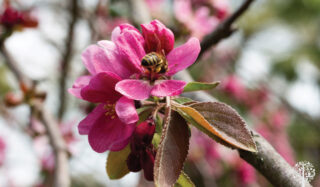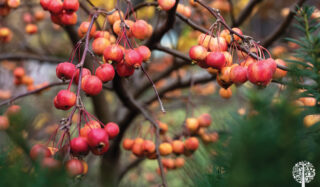Crab Apples: The Perfect Match For Pollinators
As a child, I had two big crab apple trees in my backyard. The pink and white blossoms made the landscape feel like a fairyland when they bloomed in late spring. The trees were a beacon for bees, who flocked to them to gather sweet nectar from the aromatic flowers.
As the season progressed, the trees became places to climb or sit under and read during hot days. In late summer, the apples that weren’t harvested fell to the ground or remained on the tree, providing food for birds and neighborhood wildlife.
Although the apples were tart and not great for eating raw, they were delicious once they turned into pies, tarts, crisps, apple sauce, or jelly. In autumn, the transformation of the leaves to bright red, orange, and yellow added one final ornamental touch to the landscape.


Why You Should Plant Crab Apples
When considering edimentals, fruit trees aren’t often top of the list, but these yearly stalwarts are vital components of the edimental garden.
To learn more about edimentals: What is an Edimental Garden? | Garden Culture Magazine
Deliciously Low-Maintenance
Crab apple trees are tough. Most varieties are hardy to climate zone 4 (-30°C) and can tolerate most soil types as long as regularly watered, given a good mulch of compost around their base, and planted in full to part sun. In late winter, remove any dead, dying, diseased, or crossing branches and any suckers growing out of their base. By doing this, the trees will happily produce fruit for decades. The trees in my backyard were at least 50 years old.
Most crab apple trees aren’t prone to pests and disease, but you can purchase disease-resistant varieties to minimize the chances of apple scab, fire blight, and apple rust. Pests like Japanese beetles, caterpillars, and apple maggots will rarely do enough damage to impact the tree’s health. Deer, on the other hand, will enjoy light fruit snacks hanging from lower branches.
More commonly, crab apples, as most fruit trees, are propagated by grafting. The flowering part of an existing tree (the scion) is attached to the lower part of another tree (the rootstock). The fruit produced from the graft is identical to the scion used and retains the same appearance and taste as the originally grown apple.


Sweet and Tart
You can make many recipes with a harvest of crab apples. Every fall, I gather crab apples from a friend’s tree and make crab apple jelly. But what about crab apple liqueur? Fill a jar with chopped crab apples and 1 ½ cups of vodka. Store out of sunlight on its side and rotate the jar daily for two weeks. Strain and enjoy. It’s that easy!
For more recipes: Crab apple recipes – BBC Food
Crab Apple Varieties
There are around 35 species of crab apple trees and hundreds of hybrids. Most garden centers will carry crab varieties ranging from 4 meters to a whopping 12 meters in height. There’s a size to fit every garden.
Red Sentinel
This tree is highly ornamental, with pink-white flowers in late spring.
Pink Glow
Pink Glow produces single, white flowers in spring, followed by larger-than-average dark pink fruits in summer.
Comtesse de Paris
White flowers and oval-shaped fruits follow Pink buds on this tree.
Wisley Crab
Delicately scented, reddish-purple flowers appear in spring, followed by dark red fruit on the Wisley crab.
Winter Gold
Winter Gold features white spring flowers, yellow fruit, and dark green leaves that turn red and orange in autumn.
To learn more about crab apple trees, Search the RHS website for gardening knowledge / RHS
You won’t be disappointed if you add this edimental to your garden!




